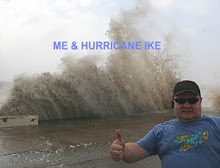SKYWARN & SDS Session
 One of the fortunate aspects of living in North Texas is having such an outstanding National Weather Service office serving this region. Part of that is the superb Advanced SKYWARN presentations of Gary Woodall and the advanced sessions of Al Mollar. They somehow find a way to keep topping the previous year's excellent presentations. 2006 is certainly no different. Of course, these sessions certainly come at an excellent time when the debilitating effects of SDS start to peak for us chasers.
One of the fortunate aspects of living in North Texas is having such an outstanding National Weather Service office serving this region. Part of that is the superb Advanced SKYWARN presentations of Gary Woodall and the advanced sessions of Al Mollar. They somehow find a way to keep topping the previous year's excellent presentations. 2006 is certainly no different. Of course, these sessions certainly come at an excellent time when the debilitating effects of SDS start to peak for us chasers.Once again, some of my video along with several other chasers' was used to help storm spotters visualize various storm features and dynamics. It is always a privilege to be able to help in efforts to assist spotters in their critical role in an integrated warning system. Gary's several-hours long session is top notch and very professional. At least in my opinion, he accurately conveys many complex aspects of storm physics, characteristics, and meteorology to the general public in a very energetic and entertaining manner. The measure of his success is demonstrated by most all audience members staying for his entire presentation as well as reflected in their questions. I also think Gary deserves a marathon award not only for his voice holding out for that long, but for the extremely demanding schedule this time of year as he treks to every county in their warning area to make this presentation.
Al Mollar then makes his fascinating presentation of tornadogenesis theories and every year he has some case studies of historical events. For 2006, he focuses on the very active 1976 severe weather season here in northern Texas. Several events are studied in detail including the Brownwood monster tornado, the powerful derecho event in the NW and W parts of North Texas (110mph winds and golfball hail!), and the tornadic supercell outbreak along the I-35 corridor from Denton to the North Dallas tornado to the Johnson/Ellis county supercell to the central TX cells. Included are several highly detailed surface maps that he detailed by hand with colored pencils. With upper air, skew-t and radar data thrown in, I was deeply immersed in some serious analysis. However, the skewt charts were more than several audience members wanted to ingest, so they made a hasty retreat with glazed-over eyes. LOL!! I definitely picked up on a couple of things to add to my forecasting arsenal. He showed several of his own pictures of the North Dallas tornado that he chased as a young meteorologist at the Fort Worth office. Of course, Al's recollection of the events as he tells them keeps your undivided attention.
What I would give to sit next to him on those types of days and watch his mastery at work deciphering all of the many clues and hints into pieces of art created by colored pencils. I would probably only be an annoyance though as I would want to be involved in the process and ask alot of questions. I would probably annoy myself too if I were doing a detailed hand analysis. Perhaps if I offered to keep sharpening his colored pencils? LOL! Seriously though, it definitely served to reinforce my belief in that there is no substitute for doing that kind of analysis yourself as there is no way to really get a good, in-depth understanding and feel for ALL of the intricate and detailed "personality" of the atmosphere from the surface through 200mb. Instead of colored pencils though, I use MS Paint to draw my analysis on a map image I pull off of one of several internet sources. It's easier and more convenient plus I can save it on disk for easier future reference.
Anyway, I can't recommend this session enough. Be sure to check out the schedule and attend one of the sessions that is in bold.






0 Comments:
Post a Comment
<< Home